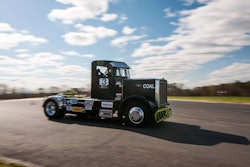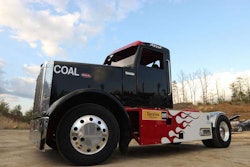Allen Boles has been racing his black and green Peterbilt 359 for years at diesel drags, tractor pulls and anywhere else he can get his racing fix, including trips to the far north of Canada to take a turn in the Rodeo Du Cameon (truck rodeo) races.
“I love big trucks, and I love racing trucks,” says Boles, a Weaverville, N.C.-based 15-truck fleet owner and truck operator.
In the last year and a half, Boles has stripped the 359 down, ending its tenure as a drag racer and building it up for a new venture: 100-mph road-course truck races at some of the top U.S. speedways.
The new Meritor ChampTruck World Series, which will bring a true big-rig racing circuit back to the United States for the first time in nearly 30 years, will pit 12 trucks, including two racers from Boles, in 10 races nationwide this year.
 Racers staged at the Le Mans Speedway in Le Mans, France, for one of the heats in the Truck Race Organization’s 2014 series finale. TRO, the European-based truck racing circuit, was the model for ChampTruck’s format.
Racers staged at the Le Mans Speedway in Le Mans, France, for one of the heats in the Truck Race Organization’s 2014 series finale. TRO, the European-based truck racing circuit, was the model for ChampTruck’s format.The first race takes place April 24-26 at the New Jersey Motorsports Park. The series will conclude Oct. 30-Nov. 1 at the Las Vegas Motor Speedway. The Aug. 28-29 races at the Texas Motor Speedway in Dallas will coincide with the Great American Trucking Show, Aug. 27-29, also in Dallas.
Series creator and promoter John Condren says ChampTruck was designed to be inclusive. Competitors don’t need to spend hundreds of thousands of dollars to build a high-end race truck, he says.
Call me Turbo
Small fleet owner and truck operator Allen Boles says his friends call him “Turbo” – a name he hopes to bring to the ChampTruck circuit. Boles will have on his Jupiter Motorsports team (a name inspired by Jupiter Enterprises, the name of Boles’ fleet) two Peterbilts – a 359 that Boles will drive and a 379 that his friend, Ricky Proffitt, will drive. The 359 will be black with a green frame, and the 379 black with a red frame. Boles received a ton of help from Carolina Cat and International when building his trucks. Pictured here is Boles’ 359 in its former role as a drag racer, the 359 under construction in Boles’ shop and the truck in its new form as a ChampTruck racer.

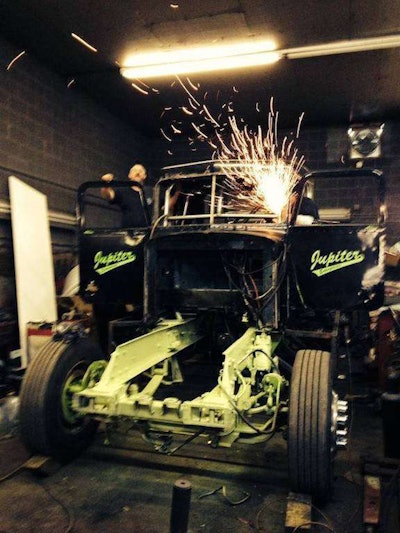
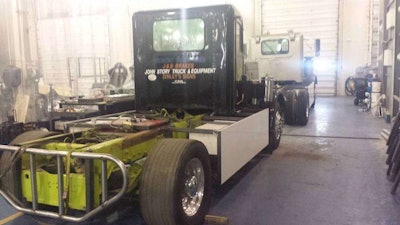
In fact, ChampTruck’s rules are designed to prohibit deep-pocket spending and level the playing field, allowing enthusiasts like Boles and Mack tech Mike Morgan of Nashville, Tenn., to compete.
“It’s not about the guy with the most amount of money,” Morgan says. “I have a real good shot, and I’m the truck-stop Joe that turns a wrench. Here I am going to be racing in the big leagues.”
While ChampTruck requires installation of certain safety equipment – a full roll cage, a racing seat and harness, electrical kill switches and a fire system that covers the truck – it also requires use of stock engines and transmissions. Trucks also have to be at least five years old and governed to 100 mph with a restrictor plate. ChampTruck also requires use of stock drum brakes and street-legal tires.
“Everything we’ve done is to try to keep costs down and maximize safety,” says Condren. “The trucks look like real trucks and run like real trucks. And the competition is going to be really close.”
In its first season, ChampTruck already has attracted diverse competitors. Teams include small fleets, owner-operators, a major team on the European truck racing circuit, a former NASCAR driver and companies such as Minimizer, which is entering two trucks.
Competing is as simple as “reading the rules, building a truck, registering your team and showing up,” says Condren.
Morgan is a testament to that simplicity and the series’ inclusive spirit. He didn’t have a big budget, but he does have big intangibles. “I’ve got more heart than any of those other guys,” Morgan says. “No one else up there will have had a hand on every nut and bolt on their truck. I have everything to lose by not doing well, so I’m going to be putting it all on the line.”
Morgan started work on his current racer in November 2013, though he’d done some work on another truck before changing his approach. Nearly all of the build work was done in his home garage during nights and weekends, with a little help from friends and his 6-year-old son.
88 MIKE
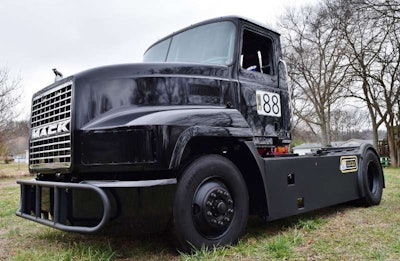 Mack tech Mike Morgan has been a diesel technician for more than 20 years and drove hot shot prior. He built his racer out of two Mack trucks, and he has a 2007 MP7 engine under the hood. He chose the No. 88 for two reasons: “88 Mike” is the name for a truck driver in the military, and he wanted to catch the eye of the National Guard, who formerly sponsored the No. 88 car in NASCAR — Dale Earnhardt Jr.’s car. No. 88 also used to belong to the NASCAR circuit’s Dale Jarrett, who was sponsored by UPS. Oddly enough, Morgan’s Mack used to be a UPS-branded truck. Click here or either of the photos to see prior coverage of Morgan and his racer.
Mack tech Mike Morgan has been a diesel technician for more than 20 years and drove hot shot prior. He built his racer out of two Mack trucks, and he has a 2007 MP7 engine under the hood. He chose the No. 88 for two reasons: “88 Mike” is the name for a truck driver in the military, and he wanted to catch the eye of the National Guard, who formerly sponsored the No. 88 car in NASCAR — Dale Earnhardt Jr.’s car. No. 88 also used to belong to the NASCAR circuit’s Dale Jarrett, who was sponsored by UPS. Oddly enough, Morgan’s Mack used to be a UPS-branded truck. Click here or either of the photos to see prior coverage of Morgan and his racer.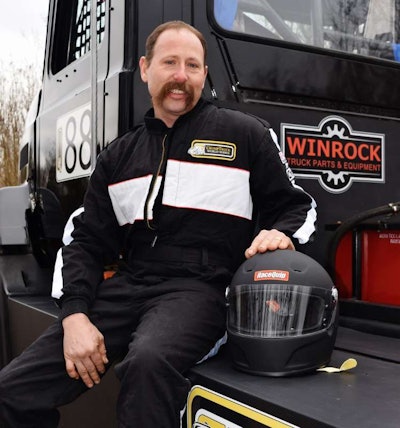
The base of Morgan’s racer is a ’99 Mack, which he crafted by combining parts from two different Macks. It’s powered by a 2007 Mack MP7 engine. He has a small sponsorship from Winrock Truck Sales in Tennessee, but nearly all the investment came from his own pockets.
He’s still trying to find sponsors to carry him through the season, but he has just enough cash to get to the first race in April. “I’ve done everything but sell the house to make this thing happen,” Morgan says. “We’re going to need help after New Jersey, but I will be there in all my glory trying to put this Mack truck out front.”
Boles, like Morgan, has been working for more than a year prepping two of his Peterbilts for the racing circuit. He’ll be racing a 359, and his buddy, Ricky Proffitt, will be racing a 379.
His 15-truck Jupiter Enterprises has been in operation since 1972 when his dad started the company. The fleet specializes in hauling coal from Kentucky to South Carolina.
Jupiter’s trucks are still in production, but Boles’ hopes to drum up support for sponsorship once he unveils them.
“We’ve been working on these things night and day for the last year, and I hope we’re going to be No. 1 and No. 2,” Boles says. “We’re going to give it our best shot. We’ll be up at the top – I guarantee you that.”
Boles’ and Morgan’s do-it-yourself approach isn’t the only avenue to participation. One of the four founding partners of the series, Bruce Hanusosky of Bruce Transporters, operates a million-square-foot fabrication shop in Painesville, Ohio, that builds ChampTruck’s stock racers.
The series itself buys trucks and transforms them into racers, which then are either sold to race teams who want a truck or leased to competitors who want to do “an arrive and drive,” Condren says.
Other ChampTruck Competitors
In addition to Boles and Morgan, roughly 10 other teams will be competing. Here is a look at Overdrive’s coverage of some of those teams. Click the images to read more on each:
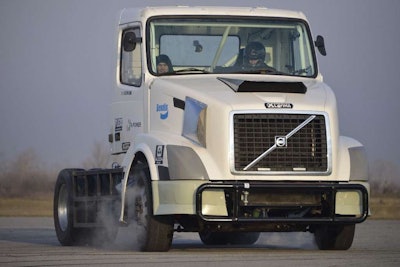 22-year-old Hungarian racer Krisztian Szabo will be racing this Volvo VNL 670.
22-year-old Hungarian racer Krisztian Szabo will be racing this Volvo VNL 670. Minimizer will be racing two trucks in the 2015 series. In addition to the No. 54 “Team Tortured” truck pictured here, they’ll run a similar “Team Tested.”
Minimizer will be racing two trucks in the 2015 series. In addition to the No. 54 “Team Tortured” truck pictured here, they’ll run a similar “Team Tested.”Hanusosky also can build racers for competitors who supply their own trucks or aid teams who build their own. For example, he added the required safety equipment, including the roll cage, for Boles and Morgan. ChampTruck also owns and maintains three trucks built by Hanusosky, available for lease during the 2015 season.
The ChampTruck idea sprouted when Condren visited a Truck Race Organization race in Europe a few years ago. Condren, a longtime motorsports enthusiast who’s been involved in racing in some form for 45 years, struck up a friendship with TRO owner and operator Fabien Calvet.
The two met several times, eventually emerging with blueprints for ChampTruck. They added partners Hanusosky and Mike Ryan, a truck racer and stunt truck and car driver.
Ryan says the series will be a great avenue to promote trucking advocacy and for outreach groups to gain exposure.
“It will give the industry the chance to talk to the general public – spectators and fans – and be effective in getting some of its messages across,” he says.
The series also offers a one-of-a-kind experience for race fans, Ryan says.
“It’s a spectacle to see these things,” he says. “It’s amazing to see them out on the track because they’re huge and they’re coming at you fast.”
How the races work
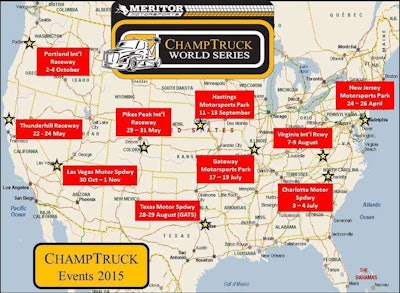
Over two days, ChampTruck competitors will race in five to six heat races. Each will last 35 minutes, and drivers earn points in each race according to where they finish.
Weekend victors will be based on the point tallies, as will an overall season champion. “We total those points up at the end of the year, and whichever team has the highest points wins the championship,” says series creator John Condren.
Though the truck races anchor the events, Condren and his partners bill the events as full weekends with a fair-like atmosphere of vendors, rides and kids’ areas. Between the truck race heats, supporting series like stock cars and formula cars will square off.
ChampTruck spectators can pay $20 for all-day access or $30 for full weekend access. Children 15 and under get in free.
All 10 races in the 2015 season will be held on road course tracks, which include left and right turns and hills, unlike NASCAR’s flat oval tracks. This puts spectators closer to the action and makes the racing more exciting, Condren says.
“You’re not going to be sitting in the nosebleed section at an oval track,” he says. “You’re going to get a close view of trucks going around the course. The trucks will speed up, slow down, take right turns and left turns, go up and down hills – a lot more action than wide-open throttle around an oval track.”
Condren expects a dozen trucks to show up to the first event next month in New Jersey, and ChampTruck’s target is to have 15 trucks racing by the season’s end.
In the 2016 season, he expects 25 to 30 trucks to compete, and they plan to cap the number at about 30 so the track won’t be overcrowded, Condren says. “They need room to move and room to race,” he says. “Trucks fill up a race track a lot faster than sports cars do.”


